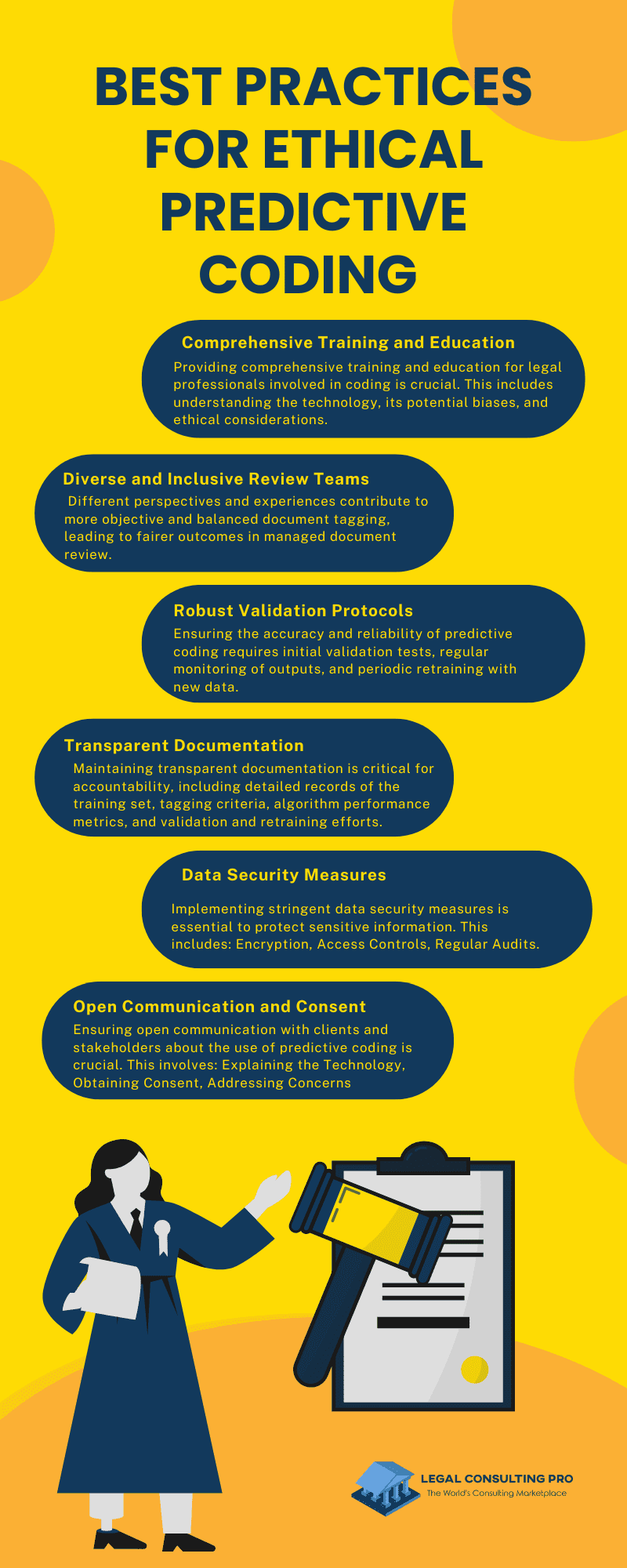Predictive coding, a form of technology-assisted review (TAR), has revolutionized the field of managed document review by significantly enhancing the efficiency and accuracy of legal document review processes. This method leverages machine learning algorithms to classify and prioritize documents, enabling legal teams to focus their efforts on the most relevant materials. However, as with any technological advancement, the use of coding in Document Review raises important ethical considerations that must be carefully addressed to ensure fairness and accuracy.
Understanding Predictive Coding
Predictive Coding involves training a machine learning algorithm to identify relevant documents within a large dataset. Legal experts manually review a subset of documents, tagging them as relevant or irrelevant. The algorithm learns from these decisions and applies its understanding to the rest of the document pool, predicting which documents are likely to be relevant. This process drastically reduces the time and cost associated with manual review, making it an invaluable tool in managed document review.
Learn more about Predictive Coding: 5 Key Benefits of Predictive Coding for Efficient Document Review
Key Ethical Considerations
-
Bias and Fairness
One of the foremost ethical concerns in coding is the potential for bias. Machine learning algorithms learn from the data they are trained on. If the training set contains biases—whether due to human error, subjective judgments, or inherent prejudices—the algorithm will replicate these biases in its predictions. This can result in unfair outcomes, such as overlooking relevant documents or disproportionately highlighting irrelevant ones.
To mitigate bias, it is crucial to ensure that the training set is representative and that the initial tagging is as objective as possible. Diverse review teams and regular audits of the algorithm’s output can help identify and correct biases. Moreover, continuous monitoring and retraining of the algorithm are essential to maintain its fairness and accuracy over time.
-
Transparency and Accountability
Coding can often be perceived as a “black box,” where the decision-making process of the algorithm is not transparent. This lack of transparency can lead to questions about accountability, especially if the outcomes of the Document Review are contested in a legal setting.
To address this, it is important to maintain detailed documentation of the predictive coding process. This includes records of the training set, the criteria used for tagging documents, and the algorithm’s performance metrics. By providing clear and comprehensive documentation, legal teams can demonstrate the validity and reliability of their coding approach, thereby enhancing accountability and trust.
-
Accuracy and Reliability
The accuracy of predictive coding is paramount in managed document review. Inaccurate predictions can lead to missed relevant documents or the inclusion of irrelevant ones, potentially impacting the outcome of legal cases.
Ensuring accuracy involves several steps:
- Rigorous Training: The initial training set must be carefully curated and reviewed by experienced legal professionals.
- Validation: Regular validation tests should be conducted to assess the algorithm’s accuracy and make necessary adjustments.
- Continuous Improvement: The algorithm should be continuously improved based on feedback and new data to maintain high accuracy levels.
-
Data Security and Privacy
The use of coding in Document Review often involves handling sensitive and confidential information. Ensuring the security and privacy of this data is a critical ethical consideration.
Organizations must implement robust data security measures, including encryption, access controls, and regular security audits. Additionally, adherence to data protection regulations such as GDPR and CCPA is essential to safeguard the privacy rights of individuals whose information is being processed.
-
Informed Consent and Autonomy
In the context of managed document review, informed consent involves ensuring that all parties are aware of and agree to the use of predictive coding. This includes understanding how the technology works, its benefits, and its limitations.
Legal teams should communicate openly with clients and other stakeholders about the use of coding, obtaining explicit consent where necessary. This transparency respects the autonomy of all parties involved and fosters a collaborative approach to document review.
Best Practices for Ethical Predictive Coding
-
Comprehensive Training and Education
Providing comprehensive training and education for legal professionals involved in coding is crucial. This includes understanding the technology, its potential biases, and ethical considerations. Regular workshops and training sessions can help keep the team updated on best practices and emerging issues.
-
Diverse and Inclusive Review Teams
Assembling diverse and inclusive review teams can help mitigate biases in the training set. Different perspectives and experiences contribute to more objective and balanced document tagging, leading to fairer outcomes in managed document review.
-
Robust Validation Protocols
Implementing robust validation protocols is essential to ensure the accuracy and reliability of predictive coding. This involves:
- Initial Validation: Conducting initial validation tests on the algorithm to assess its performance.
- Ongoing Monitoring: Regularly monitoring the algorithm’s output to identify any deviations or biases.
- Periodic Retraining: Periodically retraining the algorithm with new data to improve its accuracy and relevance.
-
Transparent Documentation
Maintaining transparent documentation of the coding process is critical for accountability. This includes detailed records of:
- The training set and tagging criteria.
- Algorithm performance metrics.
- Validation and retraining efforts.
Such documentation provides a clear audit trail, enhancing trust and credibility in the managed document review process.
-
Data Security Measures
Implementing stringent data security measures is essential to protect sensitive information. This includes:
- Encryption: Ensuring that data is encrypted both in transit and at rest.
- Access Controls: Implementing strict access controls to limit data access to authorized personnel only.
- Regular Audits: Conducting regular security audits to identify and address vulnerabilities.
-
Open Communication and Consent
Ensuring open communication with clients and stakeholders about the use of predictive coding is crucial. This involves:
- Explaining the Technology: Providing clear explanations of how coding works, its benefits, and limitations.
- Obtaining Consent: Securing explicit consent from clients and stakeholders for the use of coding.
- Addressing Concerns: Being responsive to any concerns or questions about the technology.

The Future of Predictive Coding in Managed Document Review
As technology continues to advance, the future of coding in managed document review holds great promise. Emerging technologies such as artificial intelligence (AI) and natural language processing (NLP) are poised to further enhance the capabilities of predictive coding, making it more accurate and efficient.
-
AI and NLP Integration
Integrating AI and NLP with coding can significantly improve its ability to understand and interpret complex legal documents. These technologies enable more sophisticated analysis of document content, context, and nuances, leading to better predictions and more accurate reviews.
Learn in detail: Demystifying Predictive Coding: How AI Revolutionizes Managed Document Review
-
Advanced Analytics and Visualization
Advanced analytics and visualization tools can provide deeper insights into the document review process. These tools can help identify patterns, trends, and anomalies in the data, enabling legal teams to make more informed decisions and optimize their review strategies.
-
Collaboration and Knowledge Sharing
Collaboration and knowledge sharing among legal professionals, technologists, and researchers can drive the development of best practices and standards for predictive coding. By working together, the legal industry can address ethical challenges and harness the full potential of coding for managed document review.
-
Regulatory Frameworks and Guidelines
The development of regulatory frameworks and guidelines for the use of predictive coding in managed document review can provide clear standards and expectations for ethical conduct. These frameworks can help ensure that coding is used responsibly and transparently, protecting the rights and interests of all parties involved.
Conclusion
Predictive coding has the potential to transform the field of managed document review, offering significant benefits in terms of efficiency and accuracy. However, its ethical implications must be carefully considered and addressed to ensure fairness and accountability. By implementing best practices, maintaining transparency, and fostering collaboration, legal professionals can harness the power of coding while upholding the highest ethical standards.
In the rapidly evolving landscape of legal technology, staying informed and proactive about ethical considerations is essential. As predictive coding continues to advance, its integration into managed document review must be guided by a commitment to fairness, accuracy, and the protection of sensitive information. Through thoughtful and ethical use of coding, the legal industry can achieve greater efficiency and effectiveness in managing document review processes, ultimately benefiting clients and upholding justice.







































